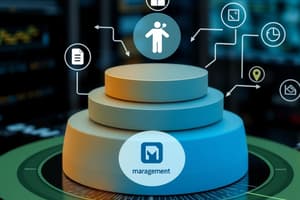Podcast
Questions and Answers
Which of the following is the MOST direct impact of information systems on business?
Which of the following is the MOST direct impact of information systems on business?
- Enhancing operational efficiency. (correct)
- Aiding in employee social interactions.
- Reducing the need for office repairs.
- Increasing office supply orders.
What is the primary strategic role of information systems within an organization?
What is the primary strategic role of information systems within an organization?
- Monitoring inventory levels.
- Managing employee timesheets.
- Scheduling staff meetings.
- Developing competitive products and services. (correct)
Supporting business decision-making at the tactical level primarily involves which type of planning?
Supporting business decision-making at the tactical level primarily involves which type of planning?
- Annual budget allocation.
- Daily task assignments.
- Long-term organizational vision.
- Medium-term planning to control performance. (correct)
Which information system activity is MOST concerned with correcting inaccuracies?
Which information system activity is MOST concerned with correcting inaccuracies?
What is the MOST important outcome of business process re-engineering?
What is the MOST important outcome of business process re-engineering?
How do decision support tools impact decision-making, according to the 'New Rule'?
How do decision support tools impact decision-making, according to the 'New Rule'?
What is the foundational purpose of transaction processing systems (TPS)?
What is the foundational purpose of transaction processing systems (TPS)?
What is the function of information systems to the managers?
What is the function of information systems to the managers?
What is the proper order of TPS Activities?
What is the proper order of TPS Activities?
What are Information System Activities Strategically?
What are Information System Activities Strategically?
Flashcards
Information Systems
Information Systems
Systems that manage and process information to support decision-making.
Functions of Information Systems
Functions of Information Systems
Activities that enhance decision-making, efficiency, and customer satisfaction.
Strategic Role
Strategic Role
Long-term planning support to achieve organizational goals.
Tactical Role
Tactical Role
Signup and view all the flashcards
Operational Role
Operational Role
Signup and view all the flashcards
Transaction Processing System (TPS)
Transaction Processing System (TPS)
Signup and view all the flashcards
Data Manipulation
Data Manipulation
Signup and view all the flashcards
Re-engineering
Re-engineering
Signup and view all the flashcards
Globalization
Globalization
Signup and view all the flashcards
Decision Support Tools
Decision Support Tools
Signup and view all the flashcards
Study Notes
Management Information Systems Module 1
- Management Information Systems (MIS) are a vital functional area for business success.
- MIS is a major resource for management challenges.
- MIS impacts operational efficiency, employee productivity/morale, and customer satisfaction and service.
- MIS is a crucial source for effective decision-making by managers.
- Effective MIS development promotes competitive products and services, which create strategic advantages in the global marketplace.
Resources/Components of Information Systems
- Information systems are composed of interconnected elements.
- Key components include people, software, hardware, data, and networks.
- Information System Resources are critical components of the system.
Functions of Information Systems
- Information systems act as a core component of business functions.
- They significantly influence the performance and overall success of an organization.
- They support managerial decision-making and improve operational effectiveness.
Information System Activities
- Information systems process inputs to generate outputs.
- Inputs can be from suppliers, regulators, stockholders, and competitors.
- Outputs are distributed to various internal and external stakeholders, including customers and competitors.
Support of Strategies for Competitive Advantages
- Includes strategic, tactical, and operational approaches.
- Strategic: Long-term plans for organizational direction.
- Tactical: Medium-term plans to manage performance.
- Operational: Daily activities and transaction processing.
Role of Information Systems
- Systems are structured to support various management levels.
- Strategic Level: Supports long-term strategic initiatives.
- Tactical Level: Supports medium-term planning and decision-making.
- Operational Level: Supports daily operations and transaction processing.
Information Systems in Perspective
- Systems vary based on the tasks they perform, the level of analysis, and user roles.
- TPS: Transaction Processing Systems for daily operations.
- MIS: Management Information Systems for effective internal data analysis and decision-making by various management levels.
- DSS: Decision Support Systems for analysis and support to decision-makers.
- ESS: Executive Support Systems for strategic planning and critical insights.
Types of Information Systems
- Systems are developed to serve various levels of management and organizational hierarchy.
- Executive Information Systems (EIS): Executive level uses these systems.
- Decision Support Systems (DSS): Support senior and middle managers.
- Management Information Systems (MIS): Supports middle managers.
- Transaction Processing Systems (TPS): Supports daily transaction-level activities.
Transaction Processing Solutions
- TPS examples include cheque processing, debt collection, debit card applications, claims processing, & loan processing.
- Features include accounts receivable and payable, general ledger maintenance, and settlements.
- Transaction solutions encompass various processes, including financial transactions and operations.
Transaction Processing System (TPS) Activities
- TPS activities include data collection, editing, manipulation, storage, and document production (e.g., reports).
Real-Time Processing vs. Batch Processing Systems
- A real-time TPS process transactions immediately.
- It's commonly used in online applications such as point-of-sale terminals. Batch processing involves accumulating transactions over a period then processing them as a set (e.g., cheque processing for a bank).
Structure of MIS
- MIS structure includes hardware, software, database, procedure, medium & message, input/output, and personnel.
Decision Support Systems (DSS) Components
- DSS uses data, communications, models, documents and knowledge to support decision-making.
Management Information Systems (MIS)
- MIS links organizational data from various sources.
- These systems incorporate data from supply chains, transactions, operational databases, and ERP systems.
- Databases from different levels (internal and external) are included to provide complete information.
Management Information Systems (MIS) Functions
- MIS systems can generate various reports, including drill-down, exception, demand, and scheduled reports.
- They provide different levels of views and analysis of data.
- MIS functions integrate operational data with external sources.
MIS Capabilities & Reports
- Different kinds of MIS capabilities help to analyze data effectively and provide insightful reports.
- Reports include drill-down, exception, demand, and scheduled reports for detailed information.
Functional Areas
- Management information systems are applied to various business functional areas.
- Functional areas include sales and marketing, manufacturing/production, finance/accounting, human resources, etc.
- Specific systems may be created for individual functional areas (such as HR MIS).
Supporting Strategies
- Globalization: Expanding into global markets.
- Business Process Re-engineering: Rethinking business processes to improve efficiency.
- Decision Support Tools: Managers make more active decisions. Updated decision-making techniques and processes are now available.
- Shared Databases: Information accessibility and use are enhanced.
- Wireless Communication: Accessibility and flexibility for field personnel increase.
Competitive Advantage
- Competitive advantage is created by superior products, services, processes, and capabilities.
- Various factors that create competitive advantages include valuable, rare, imperfectly imitable, and non-substitutable resources or qualities.
Studying That Suits You
Use AI to generate personalized quizzes and flashcards to suit your learning preferences.




